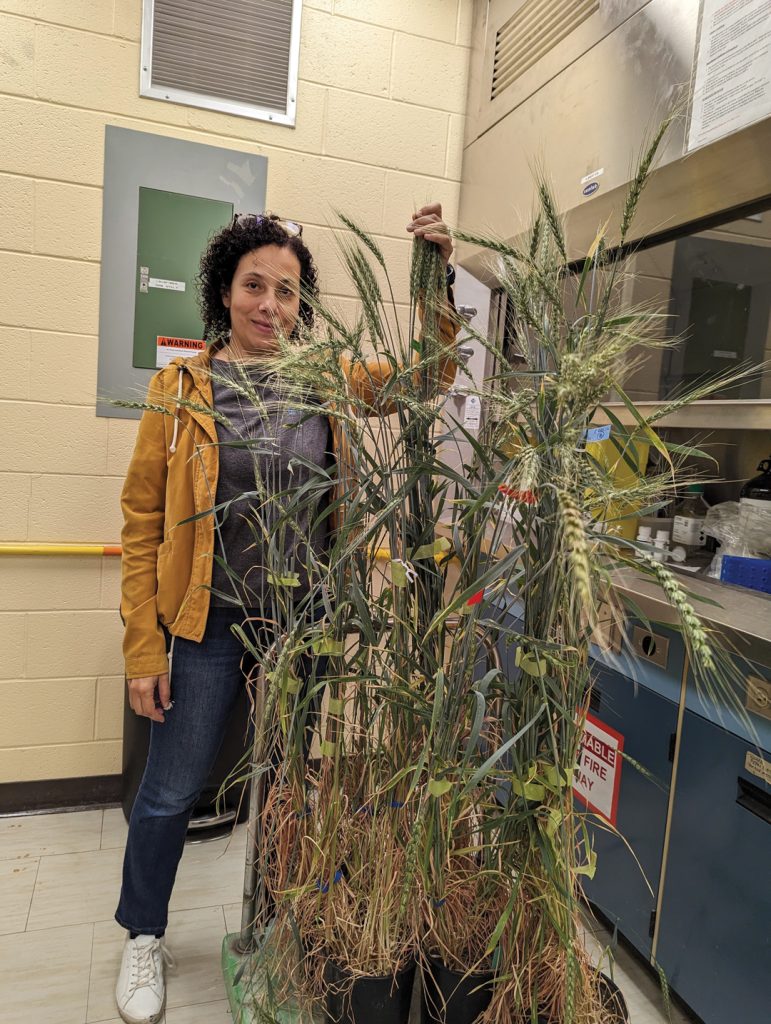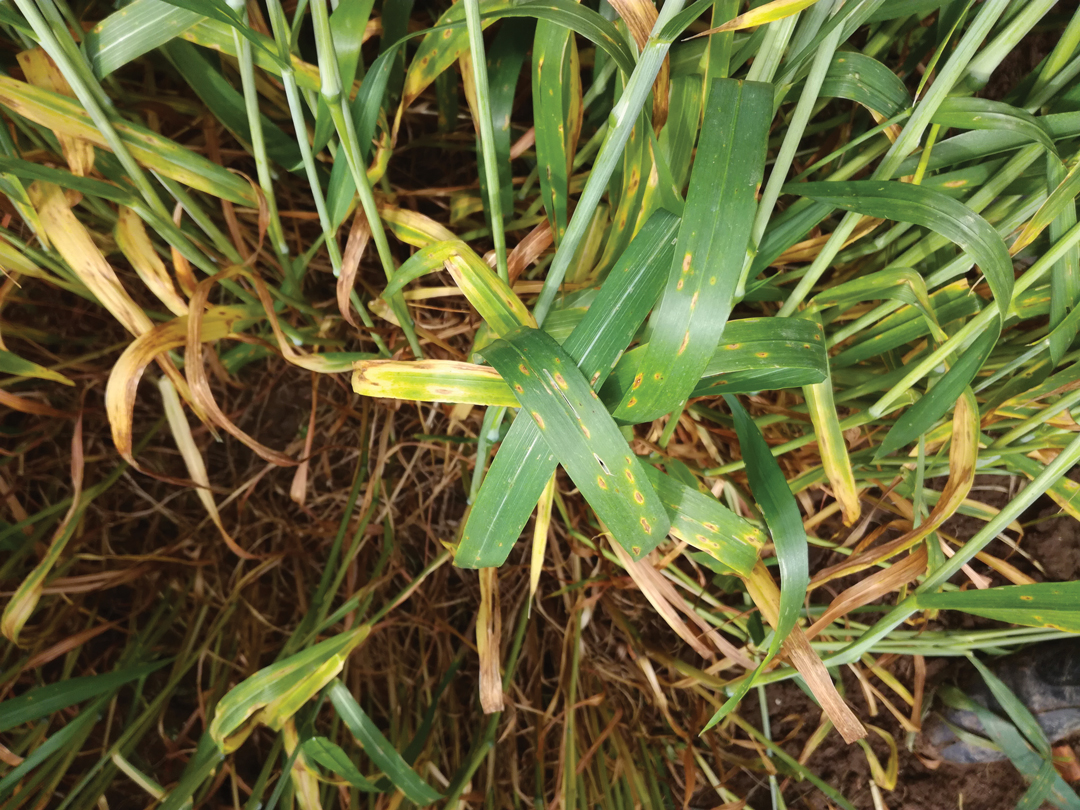CONTROL FOR A CANOPY KILLER
BY MELANIE EPP • LEAD PHOTO COURTESY OF MARWA LARIBI
On the Prairies, leaf spot complex is a significant yield robber in wheat and barley. A group of stubble-borne diseases, leaf spot complex is practically ubiquitous in Alberta cereals. Its presence can lead to downgrading, especially in bread wheats and durum. Ongoing studies aim to better understand causes and develop treatments.
Researchers are at work on quick identification tests for individual leaf spot complex diseases, fungicide application strategies and to develop resistant varieties. They are also conducting surveys to analyze the impact of cultivars, environment and geography on pathogen development while using collected samples to assess variation in pathogen virulence and fungicide sensitivity. In the meantime, crop specialists offer farmers management tips to lower the risk of yield loss.
WHAT IS LEAF SPOT COMPLEX?
Leaf spot complex, also called leaf disease complex, is the catch-all title for several fungal diseases of cereals. In wheat, the most serious are tan spot, septoria complex and spot blotch. In barley, the most damaging are scald, spot blotch and the netted and spotted forms of net blotch.
Leaf spots are necrotrophic pathogens that derive their nutrients from dead plant tissue. The pathogens use toxins and enzymes to break down and consume cell walls and membranes in the leaf canopy. These diseases are caused by various fungi. In wheat, for instance, Pyrenophora triticirepentis causes tan spot, while Parastagonospora nodorum causes septoria nodorum blotch. Cochliobolus sativus causes spot blotch, and Zymoseptoria tritici causes septoria speckled blotch. In barley, Rhynchosporium secalis causes scald, and Pyrenophora teres and Pyrenophora teres f. maculata cause netted and spotted forms of net blotch.
The group is labelled “a complex” because it can be difficult to tell their symptoms apart, especially in wheat. These vary with the host plant and the causal agent. However, typical leaf spots are oval to elliptical in shape and tan to dark brown in colour. Some have fairly dark brown margins. Lesion size varies from small flecks to spots that are several centimetres in size, especially where separate lesions coalesce. They can even encompass entire leaves.
In wheat, Pyrenophora tritici-repentis causes tan spot. Heavy infection may also cause red or pink smudge and black points on wheat kernels.
Barley, scald and netted net blotch produce symptoms distinctive from those of spotted net blotch and spot blotch, which are similar in appearance. To provide effective control, especially when using resistant varieties, farmers must identify the disease. In wheat, it can be difficult to differentiate between symptoms of tan spot and septoria complex. However, if lesions are dotted with blackish to brown asexual fruiting structures called pycnidia, it’s septoria complex. Adding to the challenge, in some cases, what appears to be leaf spot complex is bacterial leaf streak. Fungicides do not control bacterial infections, and no bactericides are available. To control a leaf spot disease it must be identified in the field. This is where surveillance and diagnostics come into play.
On average, leaf spot complex causes between five and 20 per cent yield loss in wheat, and 30 to 70 per cent yield loss in barley. Reem Aboukhaddour, a research scientist and cereal pathologist with Agriculture and Agri-Food Canada (AAFC), estimates a five per cent yield loss due to leaf spot in wheat causes approximately 1.58 million tonnes in total yield loss across Canada, which amounts to about $473 million per year.
MONITOR AND MANAGE
Michael Harding, crop health assurance lead with Alberta Agriculture and Irrigation, monitors diseases in Alberta wheat crops. While the occurrence of leaf spot wasn’t unusually high or low in 2024, severity varied. “The experience in one field isn’t going to be the same as all the other fields around it, necessarily,” he said.
However, leaf spot complex members are the most commonly occurring diseases in wheat and barley. Harding and his team take samples in a representative number of fields in each of the province’s 65 wheat-growing counties. This past growing season, they sampled 257 fields. Leaf spot diseases were present in all but 17, a whopping 93.4 per cent.
“We usually see above 90 per cent of fields with at least some leaf spot,” he said. Incidence and severity do fluctuate. On average, the percentage of leaf damage in 2024 was about 13.5 per cent. In 2023, the figure was 10 per cent, and in 2022, it was just five per cent, but in 2021 it was 11 per cent. Disease prevalence, said Harding, is influenced by several factors, including the environment, crop rotation, residue management and whether the farmer used certified seed. In 2024, the environment was not a major cause for concern in most regions.
In Saskatchewan, Myriam Fernandez assesses flag leaf samples taken by that province’s leaf spot complex and Fusarium head blight (FHB) surveys. These help the AAFC research scientist calculate the influence of crop species, environment and location (soil zone and crop district) on disease occurrence and severity. Fernandez aims to evaluate the use of beneficial agronomic practices such as summerfallow, crop rotation and tillage to assess their impact on severity.
The upside of a bad situation, ongoing drought has kept disease down across most of Saskatchewan in recent years. Unfortunately, this made it impossible to test new cultivars under disease conditions. In the recent past, greater moisture in the eastern regions of the province boosted disease prevalence.
“Red smudge is a very important downgrading factor in durum, which is quite susceptible to it,” said Fernandez. It is caused by the pathogen that causes tan spot. It was not reported in Saskatchewan in 2024. “Years ago, producers were badly hit. Pasta producers don’t like to see any specks in the flour from red smudge or black point.”
Harding said Alberta farmers are very aware of fungal leaf spot. “They’re looking for it, monitoring and measuring it, but nobody is pushing the panic button when they see fungal leaf spots.” This is because leaf spot complex diseases are not designated priority one, like FHB. They are also relatively easily managed with fungicide and a two- to three-year crop rotation.
Despite the use of these practical tools, Harding is concerned the rise in minimum and no-till systems in Western Canada means infected residue could contribute to a rise in disease incidence and severity. “As the population gets bigger, there are more opportunities for selection for more aggressive pathogens or fungicide insensitive isolates or strains,” he said.
Little can be done to avoid this. While it can accelerate breakdown and decomposition, tillage rarely affects disease prevalence, incidence or severity. He noted residue management can be a challenge in particularly productive years when biomass is high.
As an alternative to tillage, it may be more practical and effective to leave as little stubble behind as possible and thoroughly chop or remove straw where practical. There are no substitutes for crop rotation and judicious, risk-based fungicide use, he noted.
Each year, personnel from AAFC Lacombe and Beaverlodge, the provincial government and Western Crop Innovations survey Alberta barley fields for leaf spot complex diseases. Knowing which disease is present in a field helps a farmer select varieties with resistance to scald and blotch types.
Annual wheat leaf spot surveys are also conducted by provincial and federal researchers. The barley variety registration process includes extensive evaluation for resistance to members of the leaf spot complex. However, farmers must know what diseases they’re dealing with to make the right selection. In certain cases, disease may not be the problem. Chloride deficiency, for example, produces symptoms that mimic spot form net blotch and spot blotch in barley, while in wheat it can produce symptoms like those of tan spot and septoria complex.
Where identification proves challenging, farmers are advised to send samples to a diagnostic lab. Results typically take just a few days. “If farmers see a lot more leaf spot in the variety they’ve used for a few years, it might be time to change that variety,” said Turkington.
Another source of disease in the field is volunteer cereals and grassy weeds. For optimal control, eliminate these potential hosts. In barley, seed-borne netted net blotch can also be a source of disease, especially when extended rotations are used between barley crops. Knowing which pathogens are in the field assists variety selection and helps a farmer develop a tailored fungicide plan.
Additionally, Turkington is concerned about potential fungicide resistance. European and Australian farmers, he said, now deal with fungicide resistance in many leaf spot pathogens.
Of course, fungicide nonperformance could simply be a case of poor application timing. “If a grower sees fungicide performance isn’t what they expect, look at what products they’ve been using and their history of use,” said Turkington. “Maybe they need to change things up and use products with multiple modes of action.”
ONGOING RESEARCH
Seeding commercial durum varieties susceptible to leaf spot complex, particularly tan spot disease, can lead to serious economic loss. Researchers aim to minimize such risk by developing cultivars with optimized resistance and new tools for quick and easy identification in the field.
University of Alberta professor of plant pathology Stephen Strelkov studies virulence in tan spot of wheat to understand the mechanisms by which various races infect the plant and cause symptoms. He also studies pathogen races from regions where wheat originated. These include the
Fertile Crescent in western Asia and secondary centres of diversification in North Africa. Such work helps researchers understand the host–pathogen relationship and provides insight to improve management of tan spot and related diseases. “They may have effective resistance sources that we don’t have in our modern wheat varieties here,” he said. This research is supported by a Natural Sciences and Engineering Research Council of Canada Discovery Grant.
In a separate project, Strelkov aims to outline the tan spot race structure in Alberta and Saskatchewan, and identify novel tan spot resistance in durum wheat landraces for variety improvement. The work is jointly funded by Alberta Grains, Results Driven Agriculture Research, the Saskatchewan Ministry of Agriculture and SaskWheat. In collaboration with Aboukhaddour, Strelkov and others aim to detect new pathogen races or shifts in race composition that may have occurred over the past decade. The survey will include durum and bread wheat. It will also assess fungicide efficacy. The results will give agronomists effective management strategies for sustainable fungicide use.

In her work for AAFC, Aboukhaddour works to simplify pathogen identification, which she said has until now been tricky and requires laborious tests. Her lab developed a diagnostic tool that accurately identifies and quantifies the various pathogens in a disease sample. To validate its efficacy, it will be used on diseased wheat samples collected by Harding and others in Alberta and analyzed by Fernandez. The diagnostic tool will simplify lab work, reduce labour and enable quick, easy and accurate identification and quantification of pathogens. In the long-term, she hopes this data can be cross-referenced with additional variables such as environmental conditions, soil type and growth stage to better understand disease impact and assist in targeted management.
In a second project, Aboukhaddour and her colleagues work to determine the cause of necrosis in tan spot-infected durum. ToxA is a major protein or effector produced by tan spot. It causes foliar necrosis; most Canadian bread wheat and durum cultivars are susceptible. During her research, Aboukhaddour and her colleagues discovered isolates from durum do not contain ToxA, yet plants suffer extensive necrosis. “So, we knew we were looking at something else,” she said.
To determine how the various effectors produced by leaf spot diseases cause damage to durum, Aboukhaddour and her team injected protein fractions produced by the pathogen into susceptible cultivars and gauged their reactions. These factors have not previously been identified. “If you identify such a thing, you can identify the major susceptibility gene in durum,” she said. “Then you can create a marker for that gene and tell the breeder to exclude it from their plan to avoid bringing susceptibility.”
Aboukhaddour and her colleagues have narrowed the list of hundreds of possible effectors to just a few. Her work could lead to the development of new cultivars with long-term resistance to tan spot. While research into this group of diseases may be as complex as its name suggests, these Canadian scientists are producing solutions that may simplify their control.
THE DOUBLE THREAT OF BACTERIAL LEAF STREAK
According to Randy Kutcher, University of Saskatchewan cereal pathologist, farmers scouting for leaf spot diseases may mistake bacterial leaf streak (BLS) for tan spot. However, the diseases are very different. Tan spot is caused by the fungal pathogen Pyrenophora tritici-repentis. BLS is caused by two types of bacteria: Xanthomonas translucens pv. undulosa in wheat and barley and Xanthomonas translucens pv. translucens in barley. A seed-borne disease, BLS thrives in both crops, particularly under irrigation. Anecdotal evidence suggests it may cause 20 to 40 per cent yield loss.
While it can affect emergence, if infection occurs later in the growing cycle, the plant will likely produce fewer tillers and fill less grain. Symptoms include chlorotic and necrotic leaf tissue and bacterial ooze that is especially noticeable under humid conditions. As raindrops run down the leaf, the bacteria leave narrow streaks on its surface. No bactericides are yet available for BLS.
“We don’t have a lot to offer growers apart from starting with clean seed. And this is probably getting harder and harder to find as the disease becomes more prevalent,” said Kutcher. To manage BLS, Kutcher recommends the basics: choose resistant varieties when they become available, practice diverse rotations, test seed for the pathogen and always plant clean seed.







Comments